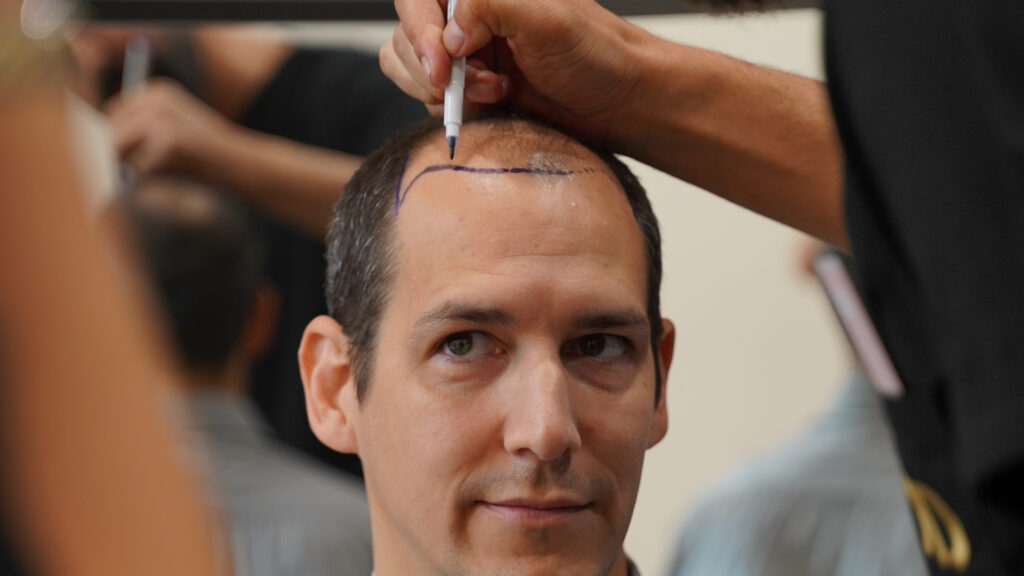Losing a few hairs daily is a normal occurrence. However, excessive hair loss can cause concern and lead to feelings of insecurity. Our comprehensive guide to androgenetic alopecia provides you with all the information you need, along with effective solutions to combat hair loss.
What is androgenetic alopecia?
Androgenetic alopecia is characterised by unusual hair loss. Unlike hair that falls out as part of the natural hair renewal process, hair loss in androgenetic alopecia is not intended to grow back. A daily loss of 50 to 100 hairs is average. When the number of hairs lost exceeds 100 per day, or when an area of the scalp loses more hairs than the rest of the head, the hair loss can be considered pathological. This is called alopecia.

There are different types of alopecia, including scarring alopecia, traction alopecia and androgenetic alopecia. Androgenetic alopecia is unique because it is caused by hormones and results in the gradual disappearance of hair on the crown, vertex, and temples in men and a thinning of hair in women. The hair loss occurs gradually and diffusely.
Androgenetic alopecia can sometimes be mistaken for other types of hair loss, such as telogen effluvium, which resolves without treatment, and alopecia, which causes sudden patchy hair loss.
What causes androgenetic alopecia?
While it manifests differently in men and women, androgenetic alopecia originates from genetic and hormonal factors in both cases.

In men
Androgenetic alopecia results from a genetic predisposition and the action of androgens, male sex hormones. With a genetic predisposition, the hair follicles on the scalp are particularly sensitive to the action of androgens, specifically dihydrotestosterone (DHT), a substance derived from testosterone. The action of this hormone affects the hair growth cycle. This hair cycle lasts, on average, three years for a man and five years for a woman.
Each cycle consists of three phases:
- The anagen phase: a growth phase that lasts between 2 and 6 years
- The catagen phase: a 3-week phase that is characterised as a transition period.
- The telogen phase lasts 2 to 3 months and leads to the death and fall of the hair.
Each hair has between 20 and 25 cycles. If these cycles keep a regular rhythm, they are supposed to ensure an individual’s hair density throughout life.
In the case of androgenetic alopecia, DHT shortens the hair cycle of certain hair follicles, speeding up the hair production process. This leads to the depletion of the hair capital and causes the hair to become increasingly thin. Eventually, the follicle will die and disappear.

In women
If androgenetic alopecia is less common in women, it is because of their lower androgen levels. Increased sensitivity of the hair roots to male hormones and a genetic predisposition to this stimulation causes female androgenetic alopecia.
The adrenal glands and the ovaries carry out the secretion of male hormones. It is entirely normal and occurs at much lower levels than in men. However, if a genetic predisposition exists, even this lower level of androgens can cause hair loss. The hair growth cycles similarly speed up, leading to early exhaustion of the hair follicles.

At what age does androgenetic alopecia begin?
Androgenetic alopecia becomes increasingly prevalent with age but can occur as early as one’s 20s.
- By age 20, 20% of men are affected by androgenetic alopecia,
- At age 30, 30% show signs of baldness,
- By the age of 40, 40% of them are victims of hair loss.
In women, 25% experience androgenetic alopecia between the ages of 35 and 45, and 35 to 45% after age 50. This hair loss can be linked to hormonal changes such as puberty, motherhood, pre-menopause, or menopause.

Diagnosing androgenetic alopecia
In men and women, androgenetic alopecia is graded according to its severity on two scales. Diagnosing and classifying androgenetic alopecia allows for the most appropriate response.
In men: the Norwood-Hamilton scale
The Norwood-Hamilton scale is the most widely used classification system for hair loss in male subjects. Adopted by virtually all medical professionals, this classification system uses seven stages to classify male pattern baldness based on the distribution of hair loss.
- Stage 1: Stage 1 is characterised by very slight balding of the temporal and frontal gulfs. At this early stage, predicting the evolution of hair loss is still challenging.
- Stage 2: At this stage, we notice a systematic balding of the temporal and frontal gulfs.
- Stage 3: It is at stage 3 that we can talk about baldness. The loss of hair in the temporal and frontal gulf areas is more and more pronounced, and the vertex area also begins to recede slightly.
- Stage 4: The temporal gulfs become more profound, and the top of the skull becomes clearer.
- Stage 5: Stage 5 is characterised by accelerated hair loss. In this stage, a thin band of hair separates the frontal and vertex areas. The bald spots gradually merge, giving the impression of being almost bald.
- Stage 6: the bald area becomes larger, and the area with hair becomes horseshoe-shaped. In stage 5, the bald areas on the top of the skull and the vertex have joined together.
- Stage 7: Stage 7 is the last stage of androgenetic alopecia. Only the hair of the Hippocratic crown remains. This thin band of hair runs from the ears to the back of the neck.

In women. Ludwig’s scale
The Ludwig scale has five stages, also associated with the level of severity of androgenetic alopecia:
- Stage 1: The first stage on the Ludwig scale is characterised by progressive hair thinning on the top of the head. At this stage, androgenetic alopecia can still go unnoticed. Unlike men, the hairline is spared.
- Stage 2: Hair loss is progressing and is considered moderate. Detecting a more pronounced hair loss on the vertex is now possible. The hair loses density and volume. With time, the thinning of the hair on the central part continues to develop.
- Stage 3: The hair becomes thinner and thinner, so it is difficult to hide the scalp. The alopecia is concentrated on the entire median parting. However, a thin frontal border of 1 to 3 cm of hair of almost normal density persists.
- Stage 4: From stage 4 onwards, cases are rare. Stage 4 is characterised by diffuse hair loss and frontotemporal receding hairline.
- Stage 5: Stage 5 results in total hair loss, like male pattern baldness.

Trichoscopy
Trichoscopy is a diagnostic technique for determining the cause of hair loss and measuring the effectiveness of treatments on the hair. Simple and non-invasive, this examination is based on taking photos of the scalp and hair using video-dermoscopy. Videodermoscopy is a skin imaging technique that magnifies the photographed areas up to 70 times. The images obtained are analysed using artificial intelligence software, the aim being to analyse the following parameters.
- the average thickness of the hair shaft,
- the average number of hairs and the number of fine, medium and thick hairs,
- the number of follicular units (they can be single, double, triple or even more),
- the number of empty hair follicles,
- the cumulative thickness of the hair.
The examination is performed by a practitioner specialising in video-dermoscopy. It takes between 20 and 30 minutes and is entirely painless.
How common is androgenetic alopecia?
Androgenetic alopecia is by far the most common cause of baldness. Affecting approximately 40% of men by age 40 and one in two men by age 50, androgenetic alopecia also affects 25-45% of women whom it causes immense psychological repercussions.
The treatments for androgenetic alopecia
For men, as for women, there are several medical, surgical, and cosmetic solutions to normalise hair loss to correct it or temporarily mask its effects.

Medical treatments
Several treatments exist to limit the progression of androgenetic alopecia. These treatments aim to stimulate the hair follicles and block the action of dihydrotestosterone.
In women, Minoxidil is often prescribed in the first phase of the Ludwig scale to normalise the hair cycle. In some cases, it can be combined with anti-androgenic hormone treatment.
In men, the best-known treatment is Finasteride. This substance blocks the transformation of testosterone into dihydrotestosterone, thus slowing down hair loss.

Hair transplantation
If nearly 80% of patients opt for a hair transplant, it is because of its very satisfactory, and especially permanent, results. Hair transplants have undergone significant technological progress allowing for spectacular, natural and invisible results. Several hair transplant techniques can be proposed to fight against androgenetic alopecia and regain dense, long-lasting hair.
- FUE hair transplantation: FUE hair transplantation is based on extracting hair follicles at their roots from the donor area and reimplantation in the recipient area. The extraction uses a micro “punch” electric stylet, whose diameter varies between 0.7 and 1.1mm. Before re-implanting the hair follicles in the donor area, the surgeon uses tiny blades to make microchannels in the recipient area.
- Sapphire FUE Hair Transplant: The Sapphire FUE hair transplant differs from the traditional FUE method in the blade used to make the channels in the recipient area. The surgeon uses a sapphire blade instead of a conventional steel blade in this procedure. The sapphire blade allows for more delicate and precise incisions.
- DHI Hair Transplant: DHI hair transplant is performed using an implant stylet called Choi Pen. With it, the surgeon implants the grafts in the recipient area without making microchannels beforehand. This method has the advantage of reducing the wound and facilitating the postoperative period.

Among the treatments that can be offered to patients suffering from androgenetic alopecia is the Regenera Activa stem cell hair transplant. The Regenera Activa stem cell hair transplant is an innovative technique based on cellular regeneration. It uses the culture and introduction of mesenchymal stem cells previously extracted from the patient’s scalp. This method helps to stop hair loss and stimulate hair growth. Highly effective in combating female pattern hair loss, Regenera Activa stem cell hair transplant can be combined with a hair transplant to optimise its results.

A platelet-rich plasma PRP treatment can also complement hair transplantation. PRP treatment is a non-invasive therapeutic method aiming to inject platelets in the blood into the scalp to stimulate the hair growth process. The injection of PRP regenerates hair follicle cells, nourishes multipotent stem cells and activates microcirculation in the scalp. It can also be done without a hair transplant to fight against androgenetic hair loss and diffuse hair loss.

Cosmetic treatments
While powders and wigs can be used to camouflage androgenetic alopecia, they have the disadvantage of being unnatural and very noticeable. Hair micro-pigmentation remains the best solution for patients wishing to opt for the cosmetic treatment of androgenetic alopecia.
Hair micropigmentation, also called dermopigmentation, is a hair tattooing technique. It is based on the injection of tiny organic pigments into the superficial layer of the scalp’s epidermis. The goal: to simulate a new hair growth and create the illusion of a voluntarily shaved head. This method is particularly intended for men suffering from total baldness. Like a permanent makeup technique, the tattoo remains between 3 and 4 years old.
24592 vues
0 commentaires
1






Il n'y a pas de commentaires pour le moment.